The Ultimate Guide to Wood Interior Design: Crafting Warm, Stylish, and Sustainable Spaces
Are you envisioning a home that radiates warmth, natural beauty, and timeless appeal? Look no further than wood interior design. Wood brings an unmatched charm to any living space, effortlessly blending coziness with sophistication. Its enduring popularity stems from its ability to create inviting atmospheres, offering a connection to nature that feels both grounding and luxurious.
From the foundational elements like flooring and wall treatments to exquisite furniture pieces and subtle accents, wood possesses the remarkable power to completely transform the aesthetic and ambiance of your home. It’s a versatile material that seamlessly integrates with any decorating style, whether you gravitate towards minimalist contemporary designs, a rustic farmhouse charm, or classic elegance. Beyond its visual appeal, wood is also a wonderfully environmentally friendly choice, especially when sourced sustainably, and it boasts incredible durability that ensures your investment will last for generations.
In this comprehensive guide, we will explore the diverse ways you can incorporate wood into your home. We’ll delve into various design styles, offer practical tips for different rooms, and highlight key considerations to help you create spaces that you’ll not only love spending time in but also cherish for years to come.
Key Elements of Wood Interior Design
Wood is much more than just a building material; it’s a fundamental element that can define the character of your home. It introduces a unique blend of warmth and natural texture, effectively bridging the gap between your indoor living areas and the serene beauty of the outdoors. Its inherent quality and durability ensure that your design choices will stand the test of time, adding lasting value and style.
1. Natural Wood Accents: Bringing the Outdoors In
Incorporating natural wood accents is one of the most effective ways to infuse your home with an organic, refreshing feel. Imagine the grandeur of open wooden beams spanning your ceiling, instantly making rooms feel more expansive and connected to an architectural heritage. Pristine wooden floors, meticulously laid, provide a warm and inviting foundation underfoot, while wood wall panels can elevate an ordinary wall into a striking focal point. These panels can range from sleek, modern designs to more textured, reclaimed wood options, each offering a distinct personality.
Don’t be afraid to experiment with different wood species within a single room. For instance, pairing the light, airy feel of oak floors with the rich, deep tones of walnut furniture can introduce remarkable depth and visual intrigue to your space. This mix-and-match approach prevents the room from feeling monolithic and adds layers of sophistication. For those new to wood decor or seeking smaller impactful changes, start with subtle wooden items such as intricately carved bowls, elegant picture frames, or unique sculptural pieces. These small touches, while seemingly minor, can significantly influence the overall warmth and tactile quality of a room, making it feel more curated and lived-in.
2. Warm Color Palette: The Spectrum of Wood Tones
The vast spectrum of natural wood colors offers an incredible range of possibilities for shaping the mood and atmosphere of a room. Deeper, richer brown woods, such as the classic mahogany or dark cherry, tend to create spaces that feel inherently cozy, secure, and luxurious, perfect for libraries or formal dining areas. Mid-tone woods like poplar or natural oak are incredibly versatile, adapting effortlessly to most design styles and color schemes, making them an excellent choice for general living areas.
For a touch of rustic charm or a vibrant, welcoming ambiance, woods with red undertones, like cedar or certain types of cherry, can add a distinctive warmth. If your goal is to make rooms feel more open, airy, and flooded with light, opting for lighter woods such as ash, maple, or birch is ideal. These lighter shades are particularly effective in smaller spaces or areas that receive less natural light, reflecting brightness and creating an illusion of greater space. Conversely, woods with very dark, almost black hues, like wenge or ebony, make a bold and dramatic statement, often best utilized as singular, impactful pieces or in controlled amounts to avoid overwhelming a space.
3. Textural Contrast: Enhancing Wood’s Beauty
Wood truly shines when it is thoughtfully juxtaposed with other materials, creating dynamic textural contrast that enriches the entire design. Imagine sleek stone countertops beautifully complementing the natural grain of wooden cabinetry in a kitchen, or industrial metal lamp bases resting elegantly on warm wooden tables. These strategic pairings don’t just add variety; they enhance the inherent beauty of each material involved. The smooth, often polished surface of finished wood pairs exceptionally well with soft, inviting fabrics such such as plush cotton, luxurious linen, or cozy wool, inviting touch and engagement.
The tactile experience of moving through a room, encountering a delightful transition from hard, smooth surfaces to soft, yielding textures, makes a space far more interesting and engaging. Consider laying a thick, wool rug over gleaming wood floors, or hanging sheer linen curtains near robust wooden window frames. Even within the realm of wood itself, textural variation can be introduced by mixing smooth, finely sanded surfaces with rough-hewn, reclaimed wood elements, creating a layered visual appeal that speaks to craftsmanship and authenticity.
4. Sustainable Materials: Eco-Friendly Wood Choices
Embracing sustainable wood practices is not only environmentally responsible but also adds unique character to your home. Utilizing reclaimed wood, such as planks salvaged from old barns or dismantled buildings, gives new life to materials that might otherwise be discarded. This type of repurposed wood often carries a rich history, evident in its distinct marks, natural patina, and unique color variations that new wood simply cannot replicate, adding a story to your decor. When purchasing new wood, it is crucial to look for certifications that guarantee responsible forestry practices.
Labels from organizations like the Forest Stewardship Council (FSC) or the Programme for the Endorsement of Forest Certification (PEFC) indicate that the trees were grown, harvested, and managed in ways that support forest health, biodiversity, and community well-being, rather than causing harm. Furthermore, opting for wood sourced from local or regional areas significantly reduces the carbon footprint associated with transportation. Making thoughtful, high-quality wood choices also contributes to longevity; well-selected and properly maintained wood products can last for many decades, minimizing the need for frequent replacements and further promoting sustainability.
Types of Wood in Interior Design
The adaptability of wood allows it to be shaped and finished in countless ways, enabling it to define a multitude of distinct design aesthetics within your home. From embodying the rustic charm of a countryside retreat to the sleek lines of a minimalist modern abode, wood is a foundational material that fits seamlessly into virtually any design plan you can imagine, each style bringing its own unique character to the forefront.
Rustic Wood Design
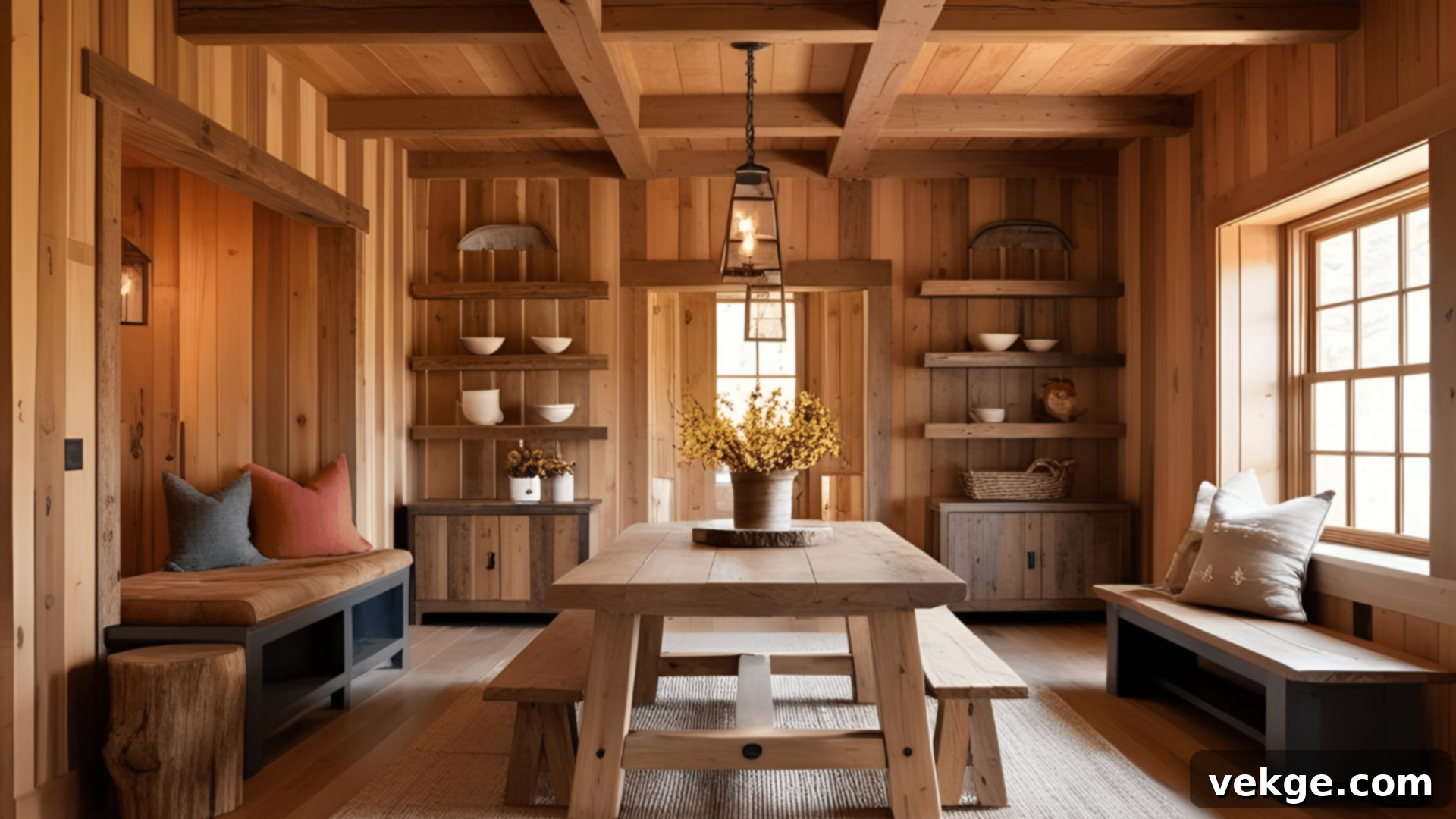
Rustic wood design is all about creating a sense of natural warmth, comfort, and unpretentious coziness. This style celebrates wood in its most authentic form, often showcasing materials that appear more natural, less processed, and sometimes even intentionally unfinished or distressed. You might encounter robust wooden dining tables where the knots and grain patterns are proudly visible, or sturdy shelves crafted from thick, unrefined wood planks. Exposed ceiling beams are a hallmark of this style, instantly imbuing any room with a charming, country-inspired character.
The color palette in rustic interiors typically draws from nature, featuring earthy browns, deep forest greens, and soft, muted reds. Rustic rooms are designed to feel inherently relaxed, lived-in, and utterly comfortable. The wood itself might exhibit a weathered, aged appearance, often achieved through specific finishing techniques or by using genuine reclaimed wood. This style thrives in settings such as mountain cabins, traditional farmhouses, or any home where the goal is to cultivate a laid-back, organic, and deeply connected-to-nature atmosphere.
Scandinavian Wood Design
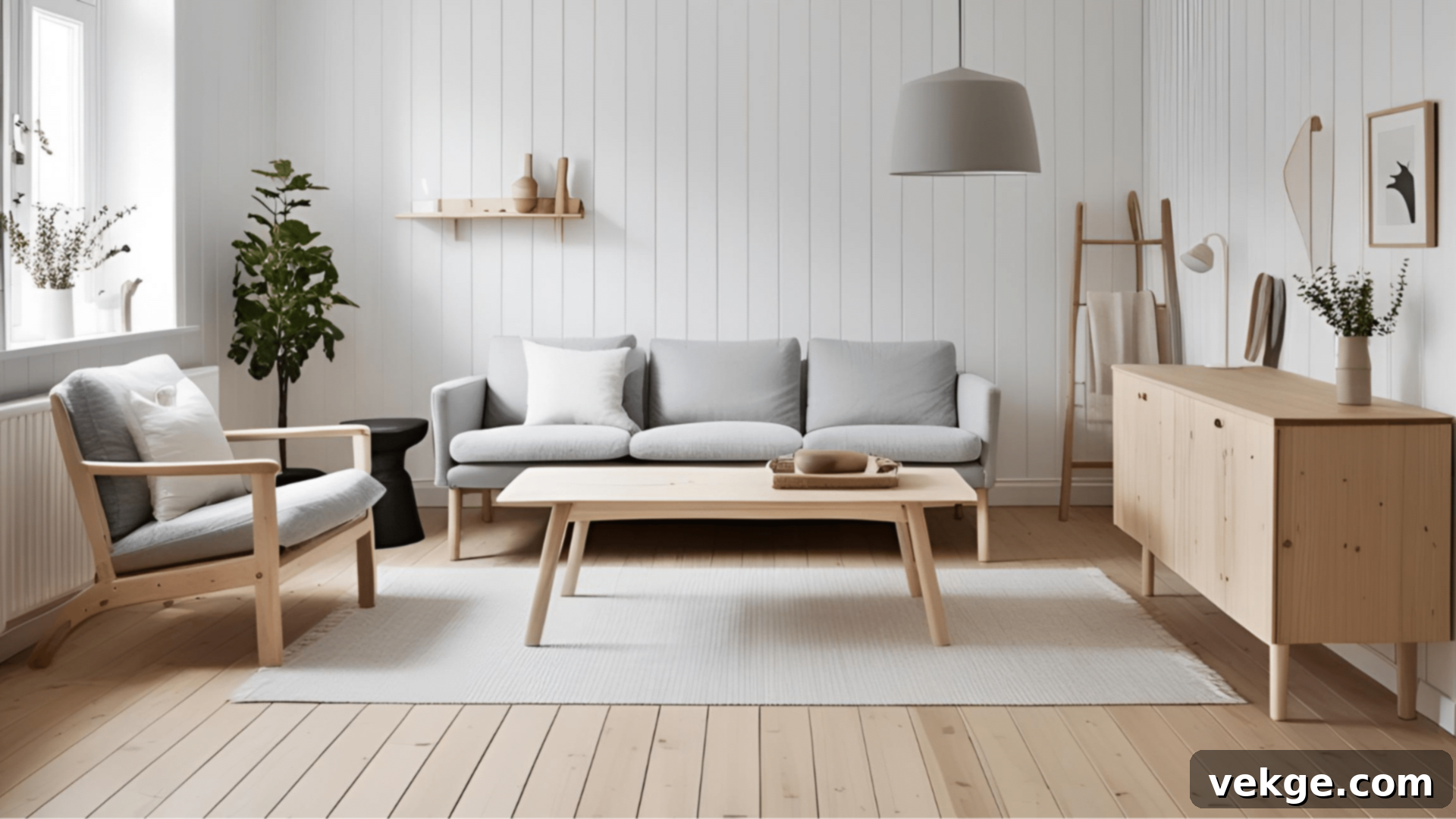
Scandinavian wood design champions simplicity, functionality, and a bright, airy aesthetic. Originating from Nordic countries where daylight can be scarce during long winters, this style prioritizes maximizing natural light and creating luminous, unencumbered spaces. Consequently, you’ll frequently see abundant white walls paired with a generous use of light-colored woods, such as pale birch, ash, or pine. Furniture in Scandinavian design is characterized by its clean lines, minimalist forms, and lack of ornate detailing, focusing instead on comfort and practicality.
Flooring typically consists of light-hued wood planks, further contributing to the overall brightness. This design philosophy strongly advocates for uncluttered environments, keeping only essential and functional items. The result is rooms that feel inherently open, tranquil, and serene. Windows are often left uncovered or adorned with sheer, lightweight fabrics to allow as much sunlight as possible to penetrate the space. Scandinavian wood design successfully creates peaceful, brilliantly lit spaces that exude an undeniable sense of openness and airy sophistication, promoting a calm and restorative living environment.
Modern Wood Design
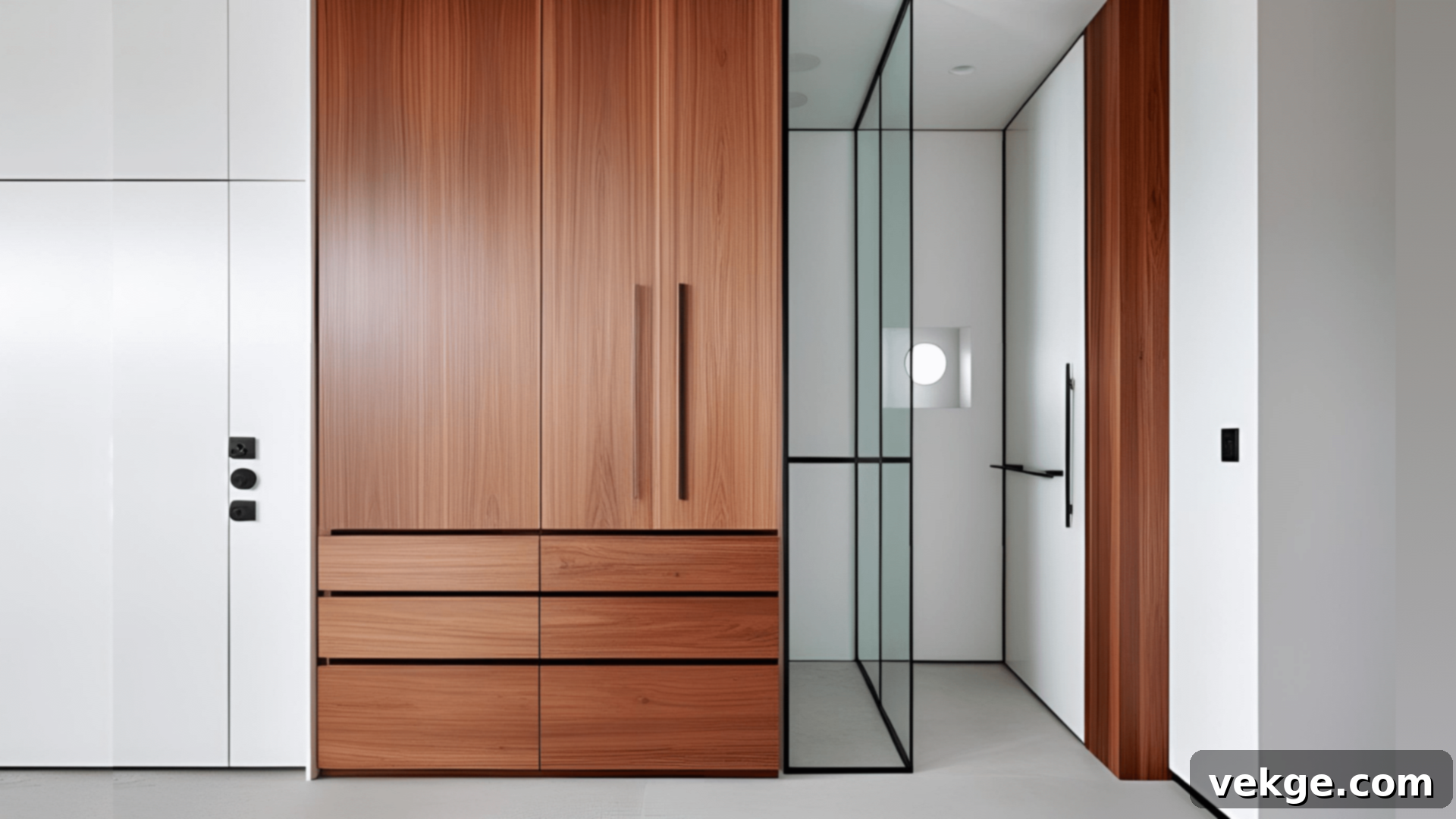
Modern wood design is distinguished by its innovative and often bold application of wood, emphasizing smooth, sleek finishes and clean, geometric forms. This style frequently features strategic pairings of wood with other contemporary materials such as polished glass, gleaming metal, or cool concrete, creating striking visual and textural contrasts. You might observe a meticulously crafted wooden accent wall standing in stark relief against a pristine white surface, or bespoke wood cabinets fitted with minimalist metal handles.
The wood itself in modern designs often boasts a clear, high-gloss finish that beautifully highlights its natural grain patterns without obscuring them. A core principle of modern design is to maintain open, uncluttered spaces, typically employing fewer, yet carefully selected, pieces of furniture. The focus is squarely on form and function, eschewing elaborate ornamentation for understated elegance. Lighting plays a pivotal role, with fixtures strategically chosen to illuminate and enhance the wood’s inherent color and intricate grain. The overall effect of modern wood design is one of clean lines, fresh perspectives, and an unequivocally up-to-date aesthetic that feels both sophisticated and functional.
Traditional Wood Design
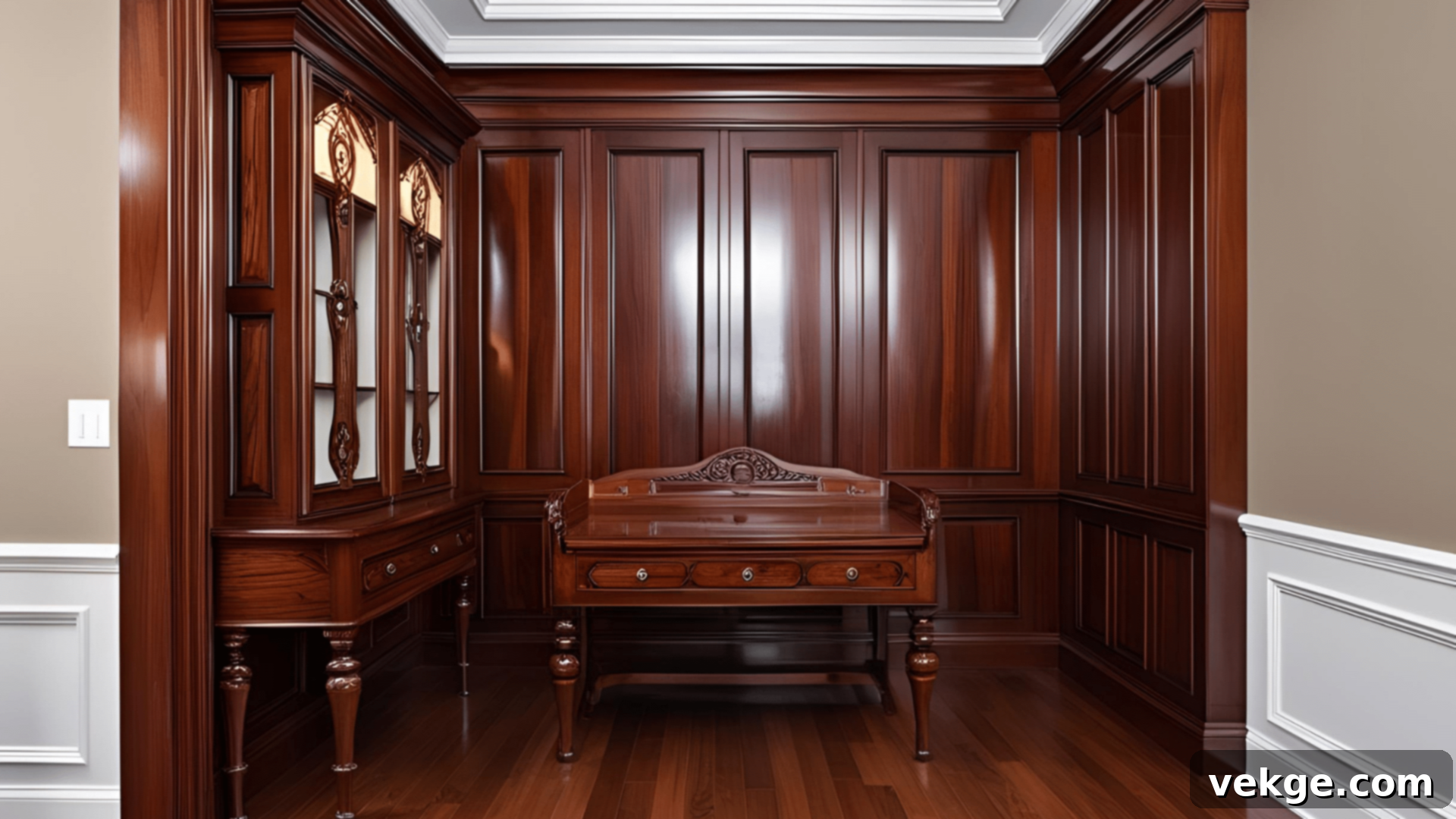
Traditional wood design evokes a sense of enduring elegance, historical richness, and meticulous craftsmanship. This style typically features darker, often exotic, woods with deep, lustrous colors such as mahogany, cherry, or dark oak. Furniture pieces are frequently characterized by their ornate details, including gracefully curved legs, intricate carvings, and classic silhouettes that speak to a heritage of fine artistry. Architectural elements like crown molding adorning ceilings and detailed baseboards along floors add a distinct layer of formality and refinement to the space, framing rooms with a sense of classical grandeur.
The wood in traditional designs often exhibits a deep, highly polished finish, reflecting light and exuding a sense of luxury. Wooden doors might feature raised panels or decorative trim work, further contributing to the structured and well-appointed feel of the room. This style makes rooms feel proper, established, and impeccably designed, often drawing inspiration from European classical aesthetics. It’s common to see intricate wood patterns, such as marquetry or parquetry, created by fitting small, precisely cut pieces of wood together. Dining tables, chairs, and bedroom sets are often part of a coordinated collection, reinforcing a cohesive and harmonious look. Traditional wood design celebrates older methods of construction, prioritizing handmade quality, attention to minute details, and an appreciation for timeless beauty.
How to Incorporate Wood into Your Home
Integrating wood into your home’s interior can be as subtle or as dramatic as you desire. With a wide array of options, from small, decorative wooden objects to expansive wood-paneled walls, you have countless opportunities to infuse your living spaces with natural warmth, texture, and undeniable beauty. Let’s explore how wood can enhance different areas of your home.
Wooden Living Room Design

- Furniture: A well-chosen wooden coffee table can instantly ground your living room, adding a natural focal point. For a more cohesive and comprehensive look, consider complementing it with matching or complementary wooden side tables, stylish bookshelves, or a contemporary TV stand. These pieces beautifully contrast with soft fabric sofas and plush upholstered chairs, creating a balanced and inviting atmosphere.
- Accent Walls: A single, thoughtfully designed wood-paneled accent wall can be a transformative element for your entire living room. It immediately becomes the room’s main point of interest, adding depth and character without making the space feel overly heavy or enclosed. Options range from reclaimed barn wood for rustic appeal to sleek, vertically slatted panels for a modern touch.
- Floors: Wood floors, particularly those in deep, rich colors like cherry or dark oak, are unparalleled in bringing warmth and elegance to a living room. Beyond their aesthetic appeal, they are exceptionally practical, effectively concealing minor dirt and enduring high foot traffic while maintaining their beauty and integrity for many years, making them a wise long-term investment.
Wooden Bedroom Design
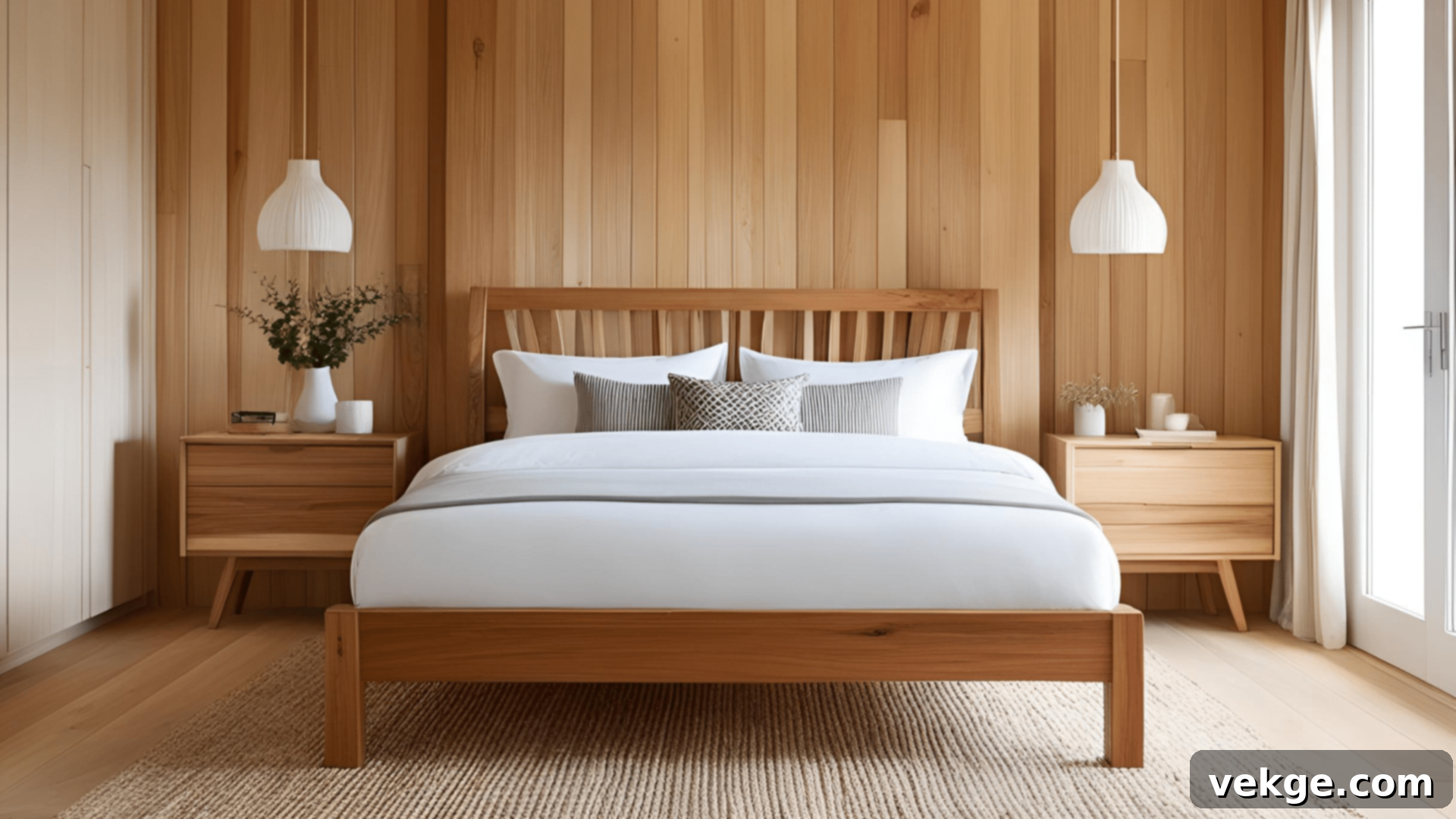
- Beds & Headboards: A beautifully crafted wooden bed frame naturally becomes the centerpiece of your bedroom, defining its style and ambiance. Opt for solid wood options, like oak or walnut, known for their durability and longevity. Even a simpler, well-designed wooden headboard can make a significant visual impact, adding a touch of natural sophistication and warmth to your sleeping sanctuary.
- Wooden Floors: Light-colored wood floors, such as maple or birch, can dramatically enhance a bedroom’s sense of space and brightness. They contribute to a feeling of openness and tranquility, often feeling cooler to the touch during warmer months. The natural grain patterns also add a subtle texture that promotes a calm and restful environment, ideal for a bedroom.
- Storage: Functional wooden dressers, spacious wardrobes, and elegant nightstands not only provide essential storage but also contribute significantly to the room’s overall style. They help keep your belongings organized and out of sight, making the room feel more harmonious, put together, and complete, while adding a timeless aesthetic.
Wooden Kitchen Design

- Cabinets: Wood cabinets are a cornerstone of kitchen design, immediately infusing the space with warmth, character, and a classic appeal. Popular choices like oak, maple, and cherry are not only aesthetically pleasing but also highly durable, capable of withstanding the rigors of daily kitchen use and often repairable if minor damage occurs, ensuring a long lifespan.
- Countertops: Wood countertops, particularly butcher block styles, introduce an undeniably homey and inviting atmosphere to the kitchen. While they require a bit more maintenance than stone or laminate, such as regular oiling and proper sealing, they possess a unique quality of developing a rich patina and becoming even more beautiful and characterful with age and use.
- Open Shelving: Incorporating open wood shelves is a stylish and practical way to display your favorite dishes, glassware, or cookbooks, making frequently used items easily accessible. They offer a more affordable alternative to full cabinetry and are particularly effective in making smaller kitchens feel more open, spacious, and less enclosed, contributing to an airy aesthetic.
Wooden Bathroom Design
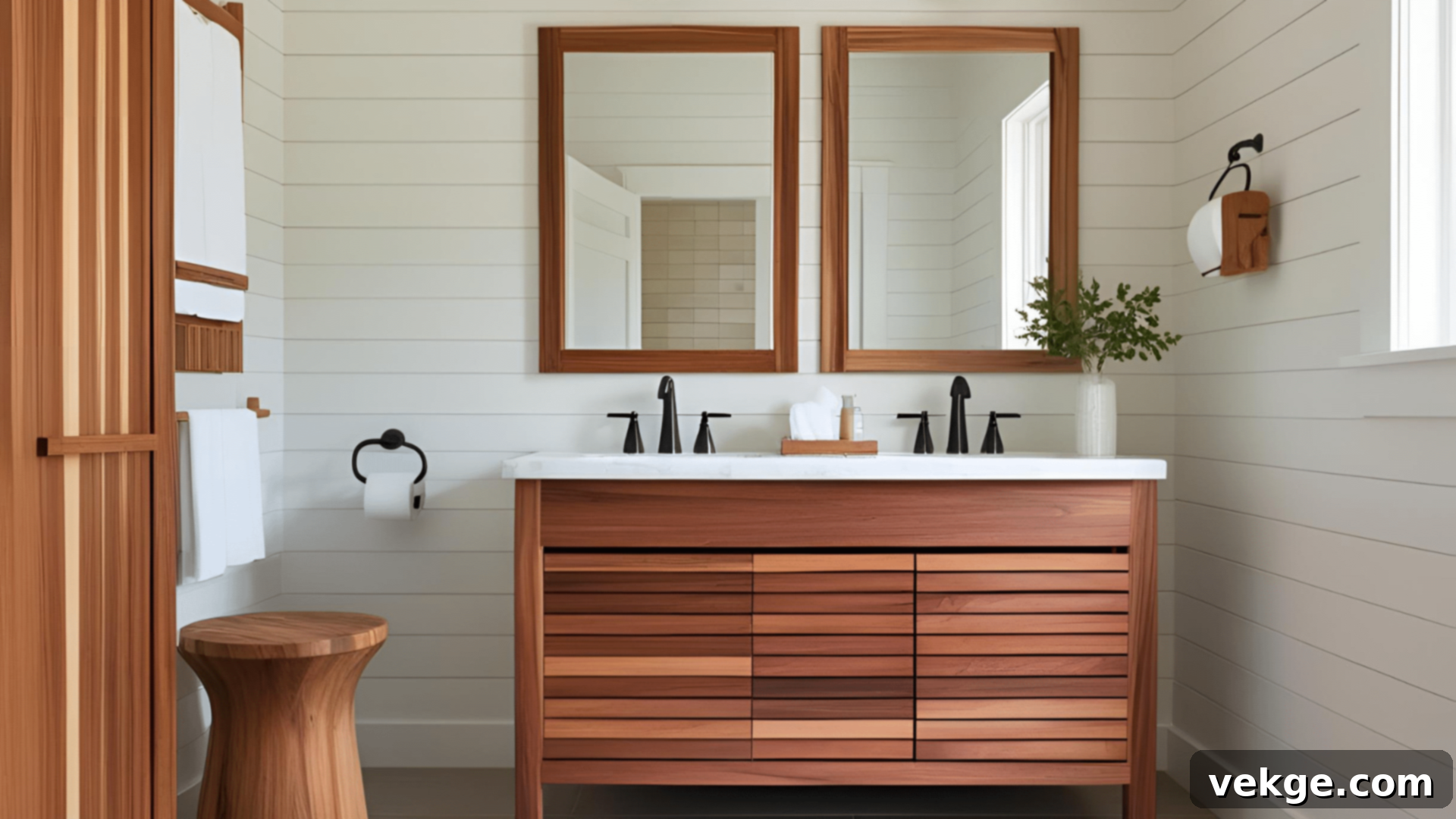
- Wood Accents: Even small touches of wood can dramatically warm up the often-cool surfaces found in bathrooms. Consider wooden mirror frames, sleek toilet paper holders, or decorative storage boxes. When selecting these, prioritize woods known for their moisture resistance, such as teak or cedar, or ensure they are properly sealed to prevent water damage and ensure longevity in a humid environment.
- Wooden Vanities: A solid wood sink vanity serves as a grounding and elegant focal point in any bathroom. Teak and cedar are excellent choices for this application due to their natural resistance to water damage, rot, and mildew, making them highly durable and practical for the bathroom environment while offering beautiful aesthetics.
- Accessories: Simple yet effective wooden accessories like bath caddies, stylish step stools, or even wooden soap dishes can elevate the bathroom experience, contributing to a tranquil, spa-like ambiance. These small, affordable additions can make a significant difference in the overall feel and aesthetic of the space without requiring a major renovation or substantial investment.
Tips for Balancing Wood Interior Design
While wood brings immense beauty and warmth, achieving a balanced wood interior design is crucial to prevent your home from feeling overly rustic, dark, or monotonous. The key lies in thoughtful integration and strategic pairing with other elements to create a harmonious and visually stimulating environment.
Mix Wood with Other Materials
To infuse your space with a fresh, contemporary vibe, strategically combine wood with diverse materials. Envision elegant wooden tables featuring sleek metal legs, or modern wood cabinets enhanced with sophisticated glass door inserts that allow spaces to feel lighter and more expansive. In the kitchen, the classic pairing of cool stone countertops alongside warm wooden cabinetry creates a beautiful contrast, adding depth and visual interest that enhances both materials.
Incorporate Light & Dark Woods
Achieving visual dynamism in your interior design often comes from contrasting wood tones. For instance, pairing the bright, airy feel of maple floors with the rich, deep hues of walnut furniture immediately creates a sophisticated interplay of light and shadow. A light wood dining table beautifully complemented by darker, contrasting chairs offers a deliberate and thoughtful aesthetic. This thoughtful blend of varied wood tones is essential for preventing rooms from appearing flat, uninspired, or overly uniform, instead giving them a layered and engaging character.
Add Pops of Color
Wood provides an excellent neutral backdrop, making it the perfect canvas for introducing vibrant splashes of color. Imagine the striking visual effect of cerulean blue pillows arranged against the warm, earthy tones of brown wooden furniture. Lush green plants are particularly effective, breathing life and natural vibrancy into spaces that might otherwise feel dominated by wood. A strategically placed, colorful area rug beneath a wooden coffee table can expertly tie a room together, adding a layer of personality without overshadowing the inherent beauty and natural grain of the wood.
Keep It Open
To ensure each wooden piece truly stands out and contributes to an airy feel, it’s vital to allow sufficient space between them. Rather than cluttering every corner, focus on selecting a few key wooden items that can command attention without overwhelming the room. Open wooden shelving units are particularly adept at allowing wall space to show through, thereby maintaining a sense of openness and preventing rooms from feeling heavy or confined. This approach emphasizes quality over quantity, allowing the beauty of each piece to be appreciated.
What to Avoid in Wood Interior Design
While wood is a highly versatile and beautiful material, certain common pitfalls can detract from its natural appeal and the overall aesthetic of your home. Being aware of these missteps can help you create a more balanced, inviting, and sophisticated wood-centric interior.
Overuse of Dark Woods
While dark wood tones exude richness and elegance, using them excessively in every design element—from floors to walls to all furniture—can make a room feel excessively dim, heavy, and even cave-like. Instead, employ dark woods strategically for one or two primary pieces, such as a statement dining table or an impressive console. It’s crucial to balance these deep tones with lighter woods, painted surfaces, or pale textiles to introduce contrast and brightness, ensuring the room remains feeling open, welcoming, and not overly oppressive.
Matching Everything
A common mistake is making all the wood elements in a room perfectly match in color, finish, and species. While coordination is good, exact matching can result in an interior that feels uninspired, overly uniform, and lacks character. Instead, embrace a more eclectic and organic look by mixing different wood types; for example, pair natural oak chairs with a rich maple table, or combine light pine shelves with a stately walnut cabinet. This deliberate mix introduces visual complexity and a more natural, collected aesthetic, making the space far more interesting and dynamic than a perfectly matched, monotonous setup.
Ignoring Lighting
Wood, by its very nature, tends to absorb light rather than reflect it, especially darker species. In rooms where wood is a prominent feature, neglecting adequate lighting can lead to a dull, shadow-filled, and uninviting atmosphere. To counteract this, it’s imperative to incorporate multiple layers of lighting, including bright overhead fixtures, ambient floor lamps, and task-oriented table lamps. Good lighting is essential for truly showcasing the wood’s inherent color variations, highlighting its unique grain patterns, and bringing its natural beauty to life. Without sufficient and well-placed illumination, even the most exquisite wooden pieces can appear flat, lifeless, and fail to make the desired impact.
Conclusion
Wood interior design is a timeless strategy for bringing the inherent beauty and tranquility of nature into your home, resulting in spaces that are not only warm and comfortable but also deeply inviting. Whether your personal taste leans towards the rustic charm of the countryside, the clean lines of simple modern aesthetics, or the refined grandeur of classic designs, wood undoubtedly enhances and elevates any room it graces. Its enduring appeal lies in its versatility and capacity to create distinctive atmospheres.
The secret to successful wood integration lies in achieving the right balance—masterfully mixing wood with complementary materials, employing a thoughtful palette of different wood tones, and ensuring that there is always an abundance of light to highlight its natural splendor. By incorporating wood with intention, in measured ways that avoid excess, you possess the power to transform your home into a serene, peaceful, and visually captivating sanctuary that reflects your unique style and values.
Wood has consistently remained a beloved design choice precisely because it offers this profound connection to the natural world while simultaneously providing exceptional durability, ensuring that your interior elements are robust enough to last for many, many years to come. For more insightful blogs on interior design and home decor, be sure to explore our website!
